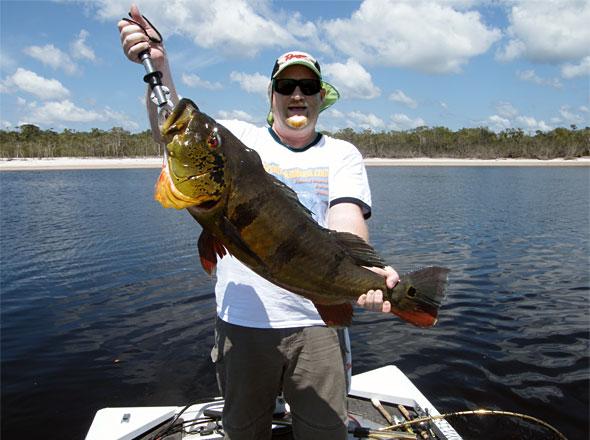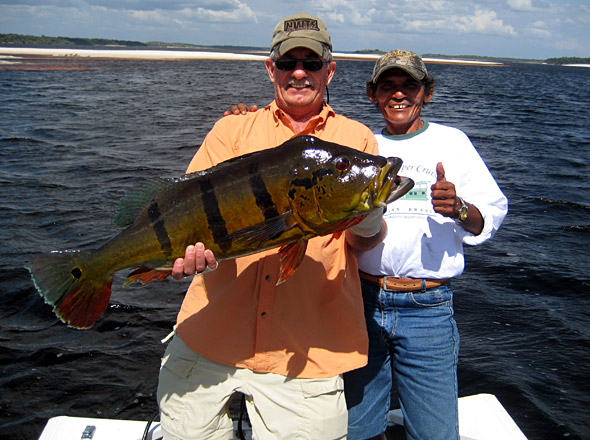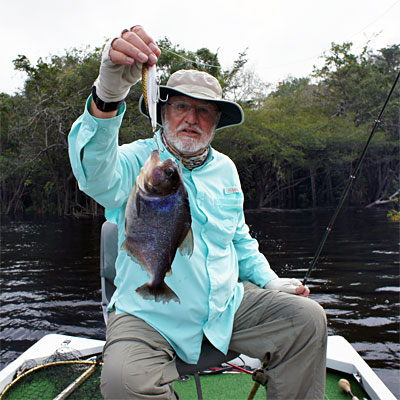Peacock Bass on The Amazon Rig!
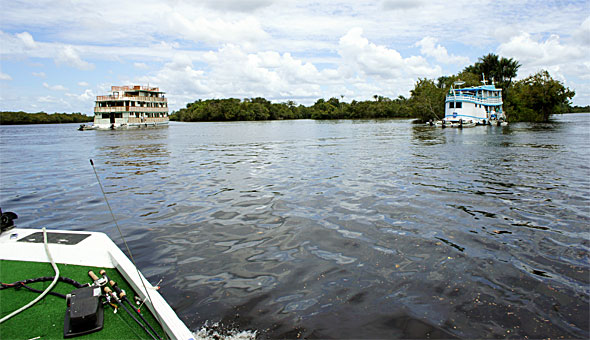
I was very fortunate to start a new adventure with Ron Speed Jr’s Adventures peacock bass fishing the mighty Rio Negro in the Brazilian Amazon jungle on February 28th, 2012! Traveling aboard the Otter houseboat on the river that produced the IGFA world record is not a bad way to spend 6 days fishing at all!
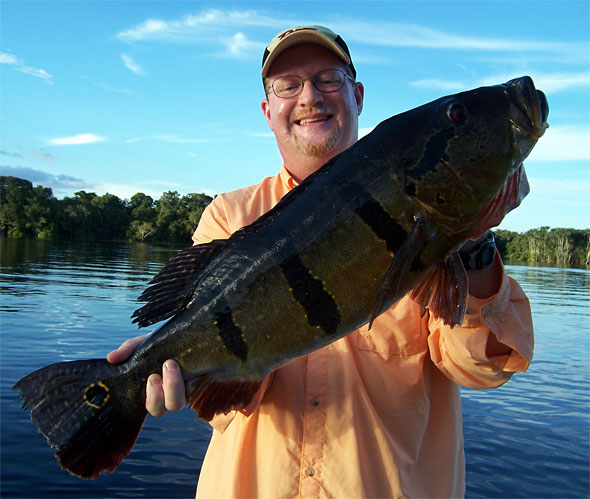
Peacock bass fishing the various Amazon River channels is usually a matter of throwing and jerking big topwater prop woodchoppers. It’s a hard workout but well worth it when a mighty Speckled Peacock Bass crushes your woodchopper like a dropped cement block!
But what do you do when the bite slows and chopping the woodchoppers isn’t calling up the big peacocks? Our 2012 trip saw the beginning of heavy rain early meaning we were fishing flooded forests of the Amazon along the mighty Rio Negro.
Peacock bass sleep at night so we had to call them out of the deep forests in the morning. They didn’t always come out eager to blast topwaters, and there were slower periods during the day t00. Since catching peacock bass of any size is always a blast anglers have lately begun throwing a wider variety of bass tackle such as jigs and big jerkbaits.
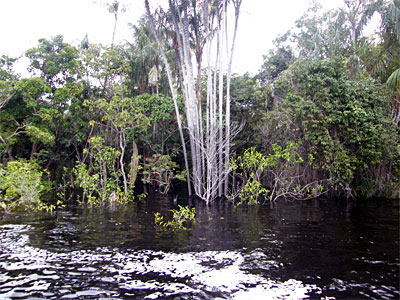
These are effective on peacock bass of all sizes including sometimes when they won’t bust the surface to smash the woodchopper. Being an adventurous type I brought along three full-size castable umbrella rigs in my tackle assortment along with a variety of small and medium swim baits and minnow bodies.
The first morning the bite was a little slow so I pulled out an umbrella rig only to have the local Indian guide look at me as if I was off my rocker. Like many anglers, something new is to be questioned and doubted… until proven. The guides know what has worked in the past and they want you to catch peacock bass so they aren’t always immediately open to time spent trying something out of the ordinary previous experience.

I had rigged up 5 medium swimbaits on minnow jigheads on my castable umbrella rig, much like the original Alabama Rig. There was an opening between two bushes that looked like a good ambush spot so I flipped my heavy umbrella rig into the opening and pulled it out with the rod and reel before the high water current could help the wood eat my rig.
As I swam my rig around the front of the trolling motor my rod tip snapped into the water and the fight was on just that quick! A small, but bruising peacock bass had eaten one of my five minnows!

After a short-line fight that included the usual drag-stripping pull of the peacock bass I flipped the bass into the boat. I had to rebend the wire arm of the umbrella rig, but I quickly got another pitch back into the same hole in the brush. WHAM! This time TWO peacock bass were on the rig, both pulling different ways at times and swimming together at other times!
After another short, knockdown dragout fight I got both bass into the net and aboard the boat. I had to rebend the wire arms back into place but I was back in business quickly. I noticed the guide was no longer shaking his head either. Now he looked slightly interested.
Another pitch into the hole in the brush and the rod snaps towards to water again as a powerful jerk tries to rip it from my hand! Two more peacock bass on the umbrella rig! This whole time the other angler in the boat with me is tossing jigs and jerkbaits into the same little hole. He can’t even get a follow up bite! It’s as if all peacock bass eyes are on the five swimbaits on my rig!?!
In all I landed 7 bass from this same small hole while my fishing partner did not get bit! It was definitely interesting. This and similar occurrences kept happening most days throughout the week as single and double peacock bass fell to what I was now calling my Amazon Rig!
Each of the first few days the various Indian guides started out disbelievers who I easily won over by the end of each day through sheer numbers of peacock bass falling to the Amazon Rig. I even started to run out of minnow bodies as peacock bass and piranha tore into and shredded them abusively!

By the 4th day of the trip word had gotten around about my rigs. The guides were now looking forward to my breaking out the Amazon Rig! They would wonder when I was going to pull it out! I found out one guide had even ‘tested’ my rig for a few minutes one evening after our fishing ended and he reported to me that he had caught THREE peacock bass at one time.
Let me tell you – ONE peacock bass at a time is about the most fun a freshwater angler can have but TWO OR MORE at one time is out of this world!! I have to admit whenever I could I still went after them with the old woodchoppers because the topwater concussion of an eating peacock is something you want to repeat often once you’ve tasted it! But I like to catch fish so whenever the topwater bite seemed slow I quickly and confidently broke out the Rig!
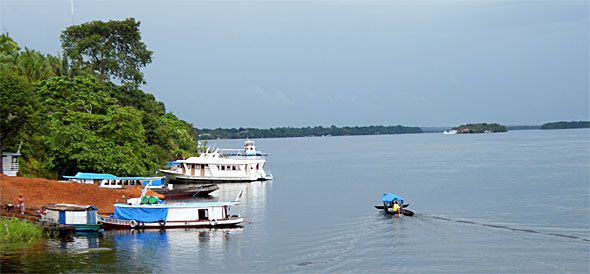
Can’t even describe how much fun it was getting bit by two peacock bass at a time while my partner sometimes couldn’t get bit at all! By the end of the week the guides all expected I would use the Rig all day because it was do effective (we fish with a different guide each day for variety and rotation). I happened to be one of the youngest people on the trip too so I took more than my share of the turn calling the peacock bass out of the deep, flooded woods each day though the guides would help out when we needed a break, or when the calling was for bass smashing far back in the woods requiring extra effort and noise to get them to come out where we could reach them.
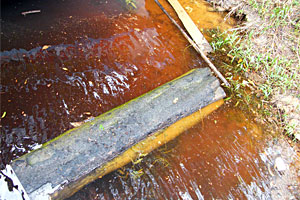
I spent a lot of time rebending wires on my Amazon Rigs but I never broke one all week despite numerous snags pitching and casting the rig between trees, logs and bushes in the heavy, high current, and having to bend the wires back out after multiple peacock bass tried to go their separate ways with my minnow bodies. I was using plastic worms, lizards and other creatures by the end of the week as I ran out of minnow bodies due to razor teeth and smashing attrition!
My advice if you’re lucky enough to get to the Amazon for some peacock bass fishing – contact Ron Speed Jr., and takes lots of minnow bodies with a handful of castable umbrella rigs packed in with your woodchoppers! You can thank me later!!
If you’re planning on turning your castable umbrella rig into an Amazon Rig make sure you have adequate tackle to handle the drag-ripping, wire-bending smash of the peacock bass. We used 7 foot heavy action casting rods with 80 pounds test P-Line Spectrex IV braid. Casts were rarely long so 7 foot worked fine but you also want to have a high speed, tough casting reel to pick up line fast since peacock bass can cover a great deal of water very fast! The 80 pounds test braid means you’re more likely to land a giant, and get your snags out too without losing your whole rig!




